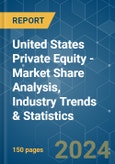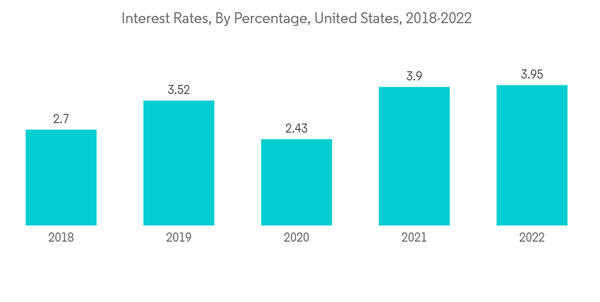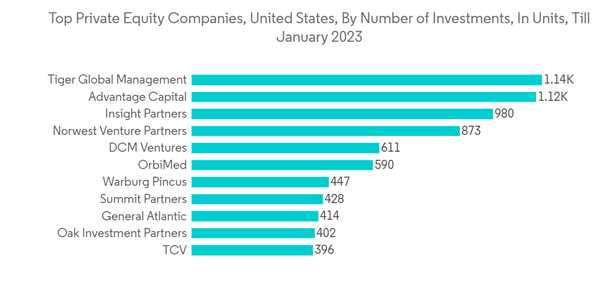The United States Private Equity Market size is estimated at USD 460 billion in 2024, and is expected to reach USD 765 billion by 2029, growing at a CAGR of greater than 11% during the forecast period (2024-2029).
The United States Private Equity Market is one of the fastest growing Private Equity Industries as business entities are more preferring venture capital and buy-out funding products for their investments and funding of organizations. There has been an increase in new funds being set up by experienced PE professionals from already established funds, resulting in high levels of deployable capital.
With competition for traditional PE deals increasing and putting pressure on returns, Private Equity firms in the United States are evolving to be diversified alternative asset managers with holdings in a variety of asset classes. This dynamic is heating up now because of two major drivers. First, private equity managers can generate higher risk-adjusted returns on assets, helping insurers generate additional spread and higher returns on equity. Second, they increase AUM, generate additional fee income, and provide a source of permanent capital through access to the insurance company’s balance sheet.
There has been a negative Impact of COVID-19 on Private Equity and other Financial Investments and Fund Raising Products in the United States. Earlier in the first quarter of 2020, 46 Private Equity Firms were shut down in the United States because of a slowdown in businesses thus, the decline in fundraising opportunities. Post-COVID the market has witnessed significant growth as people's interest towards investments grew.
Private equity funds in the United States are typically treated as partnerships for US tax purposes, regardless of whether they are organized as limited partnerships or LLCs. The fund itself is then generally not taxed in the US, except in certain instances of taxes resulting from partnership audits. Thus witnessing the growth in Businesses raising their Funds from Private Equity in the United States and estimated growth for Private Equity throughout the forecast period is seen.
Advantage Capital provides financing to established and emerging companies located in communities underserved by conventional sources of capital. Advantage Capital has won a spot on the list for its investments in small and growing businesses in economically underserved communities, to support jobs and drive inclusive economic growth.
This product will be delivered within 2 business days.
The United States Private Equity Market is one of the fastest growing Private Equity Industries as business entities are more preferring venture capital and buy-out funding products for their investments and funding of organizations. There has been an increase in new funds being set up by experienced PE professionals from already established funds, resulting in high levels of deployable capital.
With competition for traditional PE deals increasing and putting pressure on returns, Private Equity firms in the United States are evolving to be diversified alternative asset managers with holdings in a variety of asset classes. This dynamic is heating up now because of two major drivers. First, private equity managers can generate higher risk-adjusted returns on assets, helping insurers generate additional spread and higher returns on equity. Second, they increase AUM, generate additional fee income, and provide a source of permanent capital through access to the insurance company’s balance sheet.
There has been a negative Impact of COVID-19 on Private Equity and other Financial Investments and Fund Raising Products in the United States. Earlier in the first quarter of 2020, 46 Private Equity Firms were shut down in the United States because of a slowdown in businesses thus, the decline in fundraising opportunities. Post-COVID the market has witnessed significant growth as people's interest towards investments grew.
USA Private Equity Market Trends
Lower Interest Rates and Tax Benefits Raising the Private Equity Adaption In United States
Private equity firms are benefiting from significant market tailwinds triggered by historically low interest rates as well as record fundraising, which is at an all-time high with the US. The low interest rates in the United States and abundant capital continue to spur Private equity activity (lower debt financing costs) and tax law uncertainty to spur exit activity to accelerate timing and avoid potentially unfavorable tax outcomes in the forecast period.Private equity funds in the United States are typically treated as partnerships for US tax purposes, regardless of whether they are organized as limited partnerships or LLCs. The fund itself is then generally not taxed in the US, except in certain instances of taxes resulting from partnership audits. Thus witnessing the growth in Businesses raising their Funds from Private Equity in the United States and estimated growth for Private Equity throughout the forecast period is seen.
Tiger Global Management and Advantage Capital are Dominating the Market
Tiger Global Management turned down millions of dollars worth of shares in mid- and late-stage start-ups. It was done to give cash to investors in its older funds when there weren't many other options to get out, like going public. Some assets it looked to unload were bought in recent years at significantly higher valuations. Most of Tiger Global’s private investments are held by its venture funds, which are long-term vehicles, giving it the flexibility to sell now or later.Advantage Capital provides financing to established and emerging companies located in communities underserved by conventional sources of capital. Advantage Capital has won a spot on the list for its investments in small and growing businesses in economically underserved communities, to support jobs and drive inclusive economic growth.
USA Private Equity Industry Overview
The United States Private Equity Market is highly competitive and fragmented as the Private Equity business mechanism and growth-oriented approaches are undertaken by the leading companies in this market. The market is highly fragmented, also due to the presence of a large number of players in the country. Therefore, companies have been focusing more on enhancing their online presence through collaborations and partnerships. The major players include Carlyle Group, Gottenberg Associates, Chicago Capital, Vista Equity Partners, and Blackstone among others.Additional Benefits:
- The market estimate (ME) sheet in Excel format
- 3 months of analyst support
This product will be delivered within 2 business days.
Table of Contents
1 INTRODUCTION
4 MARKET INSIGHTS AND DYNAMICS
5 MARKET SEGMENTATION
6 COMPETITIVE LANDSCAPE
Methodology

LOADING...










